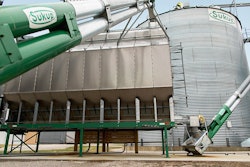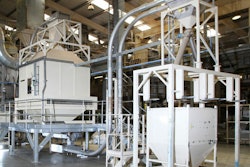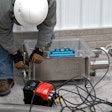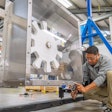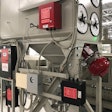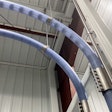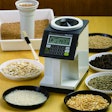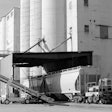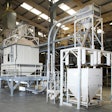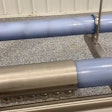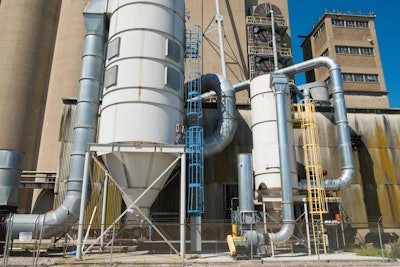
Bucket elevators are essential components in most grain handling facilities.
They are also recognized as both a circulation point for combustible dust and a potential ignition source.
A dust explosion starting in a bucket elevator can potentially travel to larger downstream volumes such as silos and upstream material handling systems, leading to devastating secondary explosions elsewhere in the facility.
Fortunately, there is a range of solutions available to protect both bucket elevators and associated process equipment from the hazard of dust explosions.
NFPA standards to protect grain bucket elevators
In general, bucket elevator protection is covered by National Fire Protection Standards NFPA 61, NFPA 68 and NFPA 69.
These standards cover methods to reduce the potential for a dust explosion (deflagration) to occur by controlling potential ignition sources, along with methods to manage a deflagration event through the use of explosion relief venting, flame-free venting, and/or suppression.
All these techniques require explosion isolation if they are to prevent propagation of a deflagration beyond the bucket elevator to other parts of the process.
Explosion prevention decision tree for grain producers
These broad themes for prevention and protection represent a choice of end points for grain producers. There are many decisions to be made in determining the safety solution. The choice of protection method is determined by the bucket elevator location and, in particular, whether it be installed inside, partially inside, or entirely outside.
Venting solutions are popular for their relative ease of deployment; the method of sizing vents and the strength of the equipment varies depending on whether the grain is raw or processed. Raw grains are addressed in NFPA 61, and processed grains in NFPA 68, while NFPA 69 prevention and protection options are applicable to both raw and processed grains.
Guiding us through the decision process and selection criteria for grain producers is Clive Nixon of Tulsa, OK-based BS&B Pressure Safety Management, a manufacturer of a broad range of dust explosion prevention and protection technologies.
At a time when global food security is of increased concern, protection of assets that support this critical infrastructure industry warrants attention.
Dust explosions at grain facilities
Grain explosions result from an ignition of dust when mixed with air during distribution, storage, or processing operations. In agricultural applications, the material might be larger, but attrition during handling can generate dust particles below 500 µm (microns), which is recognized as presenting a dust explosion hazard.
Equipment where fine airborne dust can accumulate includes mechanical conveying systems. Whenever a conveyor system is being filled or emptied, there is a potential combustible dust cloud at that point that could be ignited. All that is needed is an ignition source.
In the grain industry, equipment where dust is present is typically built for the intended use at or close to atmospheric pressure and is therefore not strong enough to withstand the high pressures associated with confined space dust explosions. In unprotected or poorly protected equipment, this can result in extensive damage and risk injury to personnel.
A small explosion event in a piece of unprotected equipment can trigger larger secondary explosions upstream or downstream. In such cases, the first explosion creates pressure waves that add turbulence and increase dust loading, followed by the large ignition source provided by the initial event.
Reduction of ignition sources
The first step in mitigating the risk for a dust explosion is preventing an event from occurring by reducing potential ignition sources. The main hazard areas in a bucket elevator are in the boot of the elevator and the head, which can cause an event that propagates up or down the leg casing(s).
Although ignition sources cannot be eliminated, they can be significantly reduced.
“For bucket elevators, this prevention takes the form of bearing temperature monitors, belt alignment monitoring, and belt slippage monitoring,” says Nixon.
Preventative maintenance on equipment can also help to reduce sources of ignition.
Reduce combustible dust levels
Dust extraction, for example, can reduce the dust concentration within the process equipment, reducing a potential fuel source. It is important for associated dust collection equipment to be protected.
Outside of the process, it is important to follow good housekeeping procedures since even relatively small amounts of combustible grain dust can pose a dangerous explosion hazard. According to the NFPA, 1/32 of an inch of such dust covering just 5 percent of the surface area of a room “presents a significant explosion hazard.”
While these measures reduce the potential for a dust explosion, the threat is not eliminated, which drives the need to implement solutions which mitigate the dust explosion once it has started within the bucket elevator.
These solutions are designed to prevent explosive pressures from rupturing the bucket elevator and should include methods to prevent explosion propagation to connected process volumes upstream and downstream.
Methods of explosion protection
According to Nixon, the primary options for explosion protection of bucket elevators are:
1. Explosion vent panels
Venting is the most widely adopted protection mechanism because it provides an economical solution and is often perceived as a fit-and-forget solution.
During the early stages of a grain dust explosion, explosion vents open rapidly at a predetermined burst pressure, allowing the rapidly expanding combustion gases to escape to the atmosphere and limiting the pressure generated within the equipment to calculated safe limits.
Explosion panels can be applied to bucket elevators located outside or close to an outside wall where the dust explosion can be safely vented to the outside via vent ducts. These panels are mounted onto the leg casing(s) and elevator head and open rapidly to relieve the explosion pressure of a deflagration.
For venting solutions, the method of sizing vents and the strength of the equipment is an important consideration when handling processed grain. For processed grain, NFPA 61 defers to NFPA 68, in which the required strength of the equipment is dependent upon the material explosivity index (Kst value). Bucket elevators handling raw grain are covered by NPFA 61.
The path for the explosion relief flame ball and the accessibility of the vent panels for occasional maintenance are important considerations when selecting this method of protection. These are covered in NFPA 61 - 2020 section 9.3.14 and NFPA 68 – 2018 section 8.8.
According to Nixon, there are some applications where the boot of the bucket elevator is inside a building and/or below grade. That creates a challenge for explosion relief venting due to the release of flame and pressure into a confined space, requiring a different protection approach for the deflagration starting in that location.
2. Flamefree™ vents
Where equipment is located inside, or where combustible material or people are present, conventional vents that will release both flame and pressure can be replaced by flamefree vents. Flamefree vents are designed to absorb the pressure wave and eliminate the flame that would normally be projected by a vented explosion.
“It is necessary to prevent a dust explosion from propagating along interconnecting ducts and through bucket elevators whose structures can typically be from 20 feet to 200 feet high. Some of this important conveying equipment is inside buildings, which obviously increases the hazard. There can be a lot of connected equipment such as weighing stations, horizontal conveyors, bins, and silos,” adds Nixon.
Flamefree vents consist of a conventional vent mounted on a housing which incorporates a stainless-steel mesh that extracts the heat of the deflagration while allowing the explosively expanding gases to be discharged safely. The mesh is configured to partially absorb the pressure wave of the expanding gases and to capture dust and soot particles to a varying degree that determines the ‘vent efficiency’ of the Flamefree venting device.
The weight and vent efficiency of flameless vents are considerations when selecting them for this application. The relevant codes are NFPA 61 - 2020 section 9.3.14 and NFPA 68 – 2018 section 8.8.
3. Explosion suppression
Active devices such as explosion suppression equipment can help to quell a small fire before it can trigger an explosion.
Explosion suppression equipment is designed to quench an explosion in its early stages before it can create destructive pressures. In the first milliseconds of the event, the equipment signals explosion suppressors to rapidly release a flame quenching medium, such as sodium bicarbonate, into the distribution or storage equipment. This effectively stops the explosion in its infancy and results in a reduced explosion pressure that is safe for the protected equipment.
‘Think of explosion suppression as a fire extinguisher that triggers automatically but at about 1,000 times the speed” says Nixon.
Suppression systems can be desirable, because the speed of cleanup and refit allows for a quick return to production. With venting or flameless venting, the explosion fully develops in the process equipment, requiring cleanup, mitigation of fire-related damage, and other consequences that take time to get the process back into operation.
This method of protection is ideal for double leg bucket elevators often used in grain handling. Protection consists of explosion detection and suppression of the elevator head and boot section of the elevator, and explosion isolation of the leg casings, feed and discharge points, and dust extraction points.
Suppression of single leg bucket elevators is also practical in grain applications although the open internal volume between boot and head will require additional extinguishing agent injection points. Most importantly, whether applied to a double leg or single leg bucket elevator, suppression systems can readily incorporate explosion isolation. See NFPA 69.
4. Explosion Isolation
Explosion isolation devices are vital to protect connected equipment and piping from propagation of a dust explosion that can result in a secondary event that can be more dangerous and destructive than the initial event. This includes isolating the feed point to a bucket elevator, the discharge point, and any dust extraction ducts.
Although explosion isolation is a component of explosion suppression systems, it is not an intrinsic feature of conventional venting and flame venting systems. With venting systems, a means of chemical or mechanical isolation must therefore be considered to prevent explosion propagation to interconnected process volumes such as dust collectors and silos. Use NFPA 69 compliant solutions and refer to NFPA 61-2020 section 9.7.4.
For grain producers and distributors, there are many critical decisions involved in selecting dust explosion prevention and mitigation equipment given the areas at risk, the methods of protection, relevant NFPA codes and the type of material being processed.
Careful attention to prevention, mitigation and isolation of bucket elevators, however, can ensure the protection of both personnel and grain handling and storage facilities.
This will also limit the potential for preventable production and business interruptions.
Contact BS&B Pressure Safety Management for more information by phone at (918) 622-5950 or e-mail: [email protected].
Author Jeff Elliott is a Torrance, CA-based technical writer who has researched and written about industrial technologies and issues for the past 20 years.




